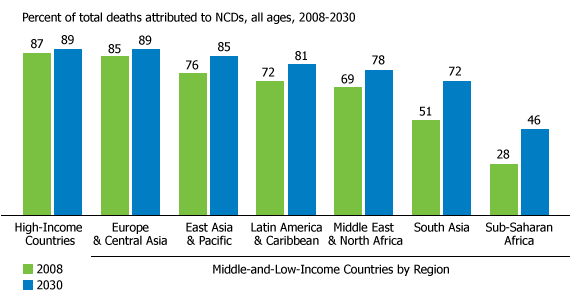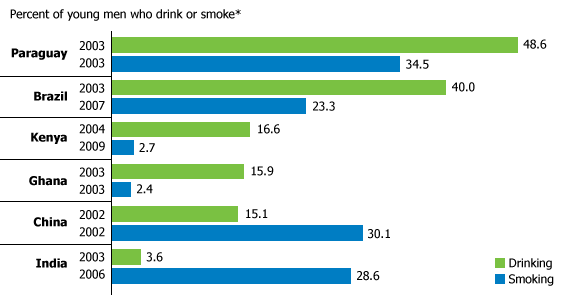
Chronic Diseases Do Affect Youth
(September 2011) It may seem odd to put “youth” and “chronic diseases” in the same category. Worldwide, not many young people currently suffer from chronic diseases such as diabetes, heart disease, stroke, cancer, and lung disease, so why worry?
The World Health Organization has made the answer abundantly clear. There is a global epidemic of noncommunicable diseases (NCDs). And the four primary risk factors for these chronic diseases—tobacco, alcohol, lack of exercise, and poor nutrition—are typically initiated during adolescence or young adulthood, setting the stage for later disease. The younger an individual starts smoking and drinking, the greater the risk of addiction and chronic disease later in life. While young people may be unwilling to adopt healthy diets and exercise programs, it is likely much easier to establish positive behaviors early than to change behaviors among middle-aged adults! Treating NCDs requires comprehensive and large health system investments, but countries could be addressing the risk factors now in their youth populations, a large and growing group in many countries.
Not convinced this is an issue for the developing world? Most developing countries are still battling infectious diseases and many think that NCDs are a problem only for wealthier countries. Sadly, NCDs are on the rise in developing countries. But because NCDs have not been a high global health priority, the data have been quite uneven, especially in developing countries.
NCDs are now the leading causes of death in most countries except in sub-Saharan Africa.1 While the share of total deaths from NCDs is projected to grow between 2008 and 2030, greater increases are expected in developing countries (see Figure 1). Sub-Saharan Africa will experience the largest increase, from 27 percent to 46 percent, followed by South Asia from 51 percent to 72 percent. In contrast, the increase will only be from 87 percent to 89 percent in high-income countries over the same period. Increases in the absolute annual number of NCD-related deaths are also striking: a 50 percent increase in low- and middle-income countries from an estimated 28 million in 2008 to 43 million in 2030.
Figure 1
NCDs Account for a Growing Share of Total Deaths, Especially in Developing Regions

Source: Irina A. Nikolic, Anderson E. Stanciole, and Mikhail Zaydman, “Chronic Emergency: Why NCDs Matter,” Health Nutrition and Population Discussion Paper (Washington, DC: The World Bank, 2011), accessed at http://siteresources.worldbank.org/HEALTHNUTRITIONANDPOPULATION/Resources/281627-1095698140167/ChronicEmergencyWhyNCDsMatter.pdf, on Sept. 2, 2011.
The Disease Burden for Low-Income Countries
To understand the burden of disease, we need to look at other measures besides death rates. There is the age at which NCDs strike. Poorer countries see higher rates at younger ages, with 29 percent before age 60.2 In richer countries, the burden of NCDs falls more to older adults who are often past their economically active years (only 13 percent of NCD deaths occur before age 60). In all cases, however, death from an NCD typically comes at the end of a period of disability; the person has already experienced lowered earning ability, greater limitations in daily activities, and increased medical care and family support. At the family level, health shocks to breadwinners can push families into poverty or impede their path out of poverty.
Not surprisingly, the risk factors for NCDs are rising in many countries. India has seen higher rates of obesity even though malnutrition is still a problem in much of the country. Tobacco use is growing fastest in developing countries, due to steady population growth and the tobacco industry’s targeted advertising campaigns aimed at new smokers. By 2030, more than 80 percent of the world’s tobacco-related deaths will occur in developing countries.3 Tobacco use is also rising among groups that typically don’t smoke, such as young females, and in large countries such as China and India. Additionally, people who live in rural areas tend to be more physically active, but when they migrate to urban areas they adopt more sedentary lifestyles. The UN estimates that half the world’s population will be living in urban areas by 2030, accelerating this trend toward reduced fitness levels and rising obesity rates.4
Most people who smoke begin in adolescence or even earlier. The risk of addiction is greater for people who start smoking at young ages. And longer exposure to toxins increases health risks.
Adolescence and young adulthood are also the years when people start drinking alcohol. As with smoking, the risk of addiction is greater for people who start drinking at young ages. Excessive alcohol consumption is a risk factor for gender-based violence, so even though young women often have lower rates of drinking than men have, women may be at higher risk for violence if their partners drink excessively. Road traffic accidents are also associated with alcohol consumption, and these accidents represent a growing cause of death and disability among young people in developing countries. Smoking and drinking are typically expensive habits that divert money from more essential activities such as food, shelter, and schooling. Figure 2 shows smoking and drinking levels for young men in several countries.
Figure 2
Drinking and Smoking Are Common Among Young Men in Many Countries, but Rates Vary

* Age groups for drinking are 18-29 and age groups for smoking vary between 18-24 in Brazil, 15-19 in Kenya and India, 15-24 in China, and 18-29 in Ghana and Paraguay. Drinking is defined as low consumption of pure alcohol. Smoking is defined as: current user, smoking tobacco (India, Ghana, Brazil, and Paraguay); or current user, cigarettes (China and Kenya).
Source: WHO Global Infobase.
Can We Reach Young People?
Research shows that enacting higher taxes on cigarettes and alcohol reduces consumption and specifically reduces it for young people. Schools can make a significant difference in consumption patterns among adolescents. For example, South Africa recently increased the hours of weekly physical education at schools.5 In a province in China, a primary and secondary school-based health program included diet education and community outreach. Students improved their knowledge of nutrition and changed their behavior when choosing school lunches.6 And in Singapore, a national healthy lifestyles program that combined media and communication strategies with skills training also resulted in a major increase in the percentage of physical activity as well as small reductions in cholesterol and glucose levels.
As a priority, developing countries should address the prevention of detrimental behaviors in adolescence. For example, programs need to focus on preventing smoking initiation and not just smoking cessation. Many of the costs of smoking are borne by the health sector, but programs to help young people resist tobacco can be spread through other sectors such as schools, community organizations, youth groups, and religious institutions, and can be supported from an array of government sectors.
While we must address how to provide appropriate medical care for those affected by NCDs, we also have a window of opportunity to build positive health behaviors among youth to reduce the burden of disease for themselves and their countries. The year 2030 may seem like a long way off, but now is the time to implement prevention strategies that will lower projected risks, morbidity, mortality, and associated costs to individuals, families, and societies.
Wendy Baldwin is president and CEO of the Population Reference Bureau. Toshiko Kaneda is a senior research associate at PRB. Lindsey Amato is a program and development associate at PRB.
References
- Irina A. Nikolic, Anderson E. Stanciole, and Mikhail Zaydman, “Chronic Emergency: Why NCDs Matter,” Health Nutrition and Population Discussion Paper (Washington, DC: The World Bank, 2011), accessed at http://siteresources.worldbank.org/HEALTHNUTRITIONANDPOPULATION/Resources/281627-1095698140167/ChronicEmergencyWhyNCDsMatter.pdf, on Sept. 2, 2011.
- World Health Organization (WHO), Global Status Report on Noncommunicable Diseases 2010 (Geneva: WHO, 2011), accessed at http://whqlibdoc.who.int/publications/2011/9789240686458_eng.pdf, on Sept. 2, 2011.
- WHO, Global Status Report on Noncommunicable Diseases 2010.
- United Nations Population Division, World Urbanization Prospects: The 2007 Revision (New York: United Nations, 2008).
- Discovery Vitality, Healthy Active Kids, South Africa Report Card 2010, accessed at www.mrc.ac.za/public/healthy_kids_report_2010.pdf, on Sept. 2, 2011.
- Xia Shi-Chang et al., “Creating Health-Promoting Schools in China With a Focus on Nutrition,” Health Promotion International 19, no. 4 (2004): 409-18.
- Vinetta Bhalla et al., “Changes in Levels of Major Cardiovascular Risk Factors in the Multi-ethnic Population in Singapore After 12 Years of a National Noncommunicable Disease Intervention Programme,” Singapore Medical Journal 47, no. 1 (2006): 841-50.
